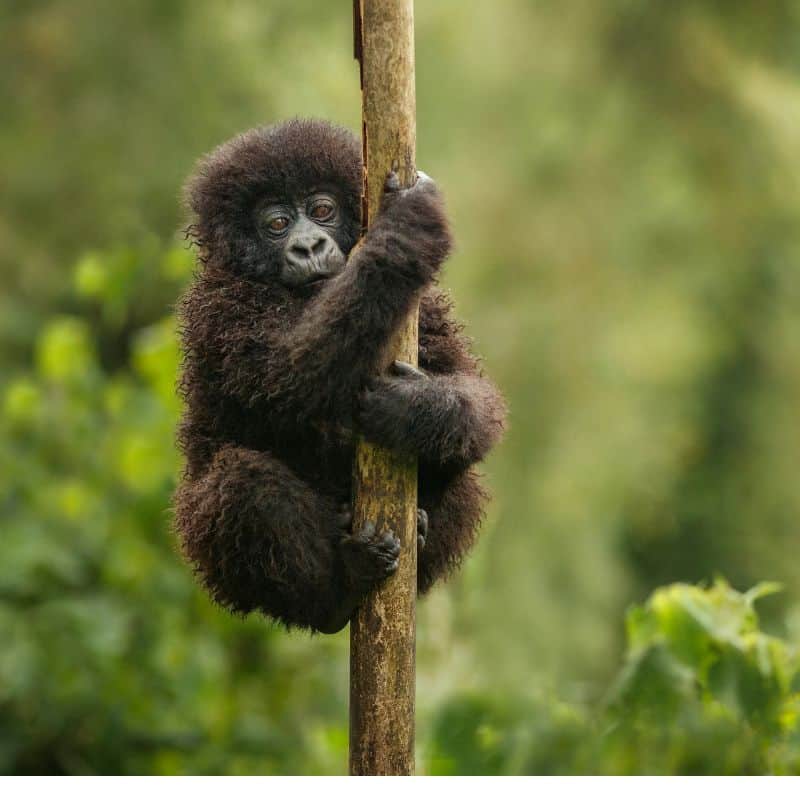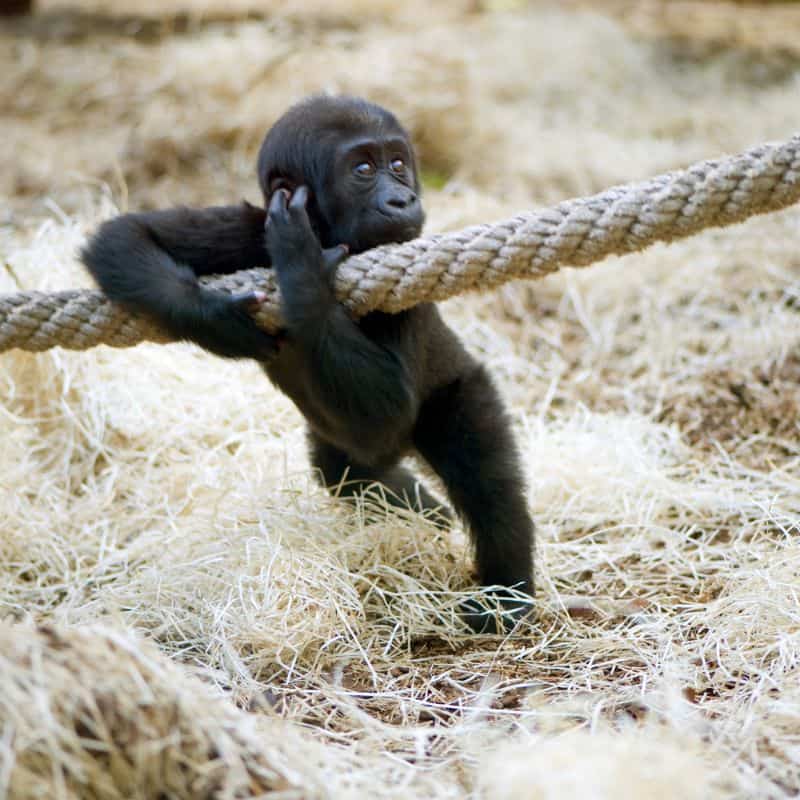While we can often see gorillas in zoos and rehabilitation centers worldwide, gorillas are rarely spotted in the wild. This might make you wonder, are gorillas endangered?
Unfortunately, both gorilla species and all four subspecies of gorillas are endangered. Disease, loss of habitat, and poaching continue to threaten the existence of gorillas. They also reproduce slowly, meaning their population growth isn’t as rapid as other animals.
The loss of a species is an unfortunate and frightening event. However, it is up to us to do what we can to protect these gorillas and prevent their extinction.
To help better understand the danger gorillas are in, let’s dive into why gorillas are endangered and how we can help prevent their extinction.

Which Gorillas Are Endangered?
There are two main gorilla species, each with two subspecies. The two species of gorillas are Eastern gorillas and Western gorillas.
Eastern gorillas are divided into the subspecies of Eastern lowland gorillas and Mountain gorillas.
Western gorillas are divided into the subspecies of Western lowland gorillas and Cross River gorillas.
Eastern lowland gorillas are primarily found in the Eastern DRC (Democratic Republic of Congo). They mostly live in the tropical rainforests of Africa.
Mountain gorillas also call the DRC home. However, they are found towards the north, in the extinct volcanic mountain range that borders the DRC, Uganda, and Rwanda.
Western Lowland gorillas mainly roam the Central African Republic, DRC, and Equatorial Guinea forests. They are also native to Gabon.
Finally, Cross River gorillas mostly appear in the rainforests of Cameroon and Nigeria.
Unfortunately, all these gorillas are endangered, and some subspecies were feared to be made extinct before the turn of the century.
Lucky for us, this was prevented, and there are still members of all subspecies of gorillas left in the wild.
There are far more Western gorillas left in the wild, and the most endangered gorillas are the Mountain gorillas. They are the most endangered for several reasons.
However, wildlife conservationists and privateers are working tirelessly to protect these gorillas and ensure population growth.
Why Are Gorillas Endangered?
There are several reasons why gorillas are endangered, and people play a significant role in the endangerment and extinction of these animals.
The four primary factors causing the population decline of Western and Easter gorillas are slow reproduction, loss of habitat, poaching, and disease.
How Does Slow Reproduction Endanger Gorillas?
Gorillas reproduce much slower than other animals. The average gestational period of a Western gorilla is 275 days, almost an entire year. For example, this is almost three times the gestation period of a cheetah.
In addition, a baby gorilla will nurse for about 2.5 to 3 years. A female gorilla usually only has one baby at a time and only produces one surviving baby every six to eight years.
Since gorillas only live to around 40 years old in the wild, you can see why it takes significantly longer for a gorilla population to grow than many other animal species.
In addition, baby gorillas are only ready to mate at six years of age, causing their population to increase slowly.
This means that the factors endangering gorillas have a much more significant effect because they reproduce slowly.
How Does Habitat Loss Endanger Gorillas?

Habitat loss is a significant factor that contributes to the declining gorilla population.
With towns and villages expanding, more natural habitat is cut down to make room. This causes a loss of habitat and food for the gorillas.
Furthermore, it forces them to retreat higher into the mountains, where dangerous conditions are less ideal.
Deforestation for palm cultivation is another great contributor to the loss of habitat for mountain gorillas. Much of this deforestation is illegal.
However, as it continues, it threatens the habitat and livelihood of gorillas, which causes them to become even more endangered.
How Does Poaching Endanger Gorillas?
Poaching is one of the biggest reasons why mountain gorillas nearly became extinct. Gorillas are hunted for trophies and meat.
The adults are often killed while the babies are sold on the black market. Gorillas are not only hunted but often fall prey to traps set up for hunting game.
The killing of gorillas is entirely illegal. However, native tribes often partake in gorilla hunting for ceremonial reasons. Parts of a gorilla are also used in traditional medicine and black magic.
This is why eradicating the poaching of gorillas is so difficult.

How Does Disease Endanger Gorillas?
Human diseases, like Ebola, pose a significant risk to gorillas, and some strains have a 95% mortality rate. Therefore, an Ebola infection may eliminate an entire troop of gorillas and devastate the general gorilla population.
Even the common cold could kill a mountain gorilla.
These factors work together to endanger the gorillas. They may lead to the extinction of one or more subspecies of gorillas if we don’t act fast and help protect these primates.
How Many Wild Gorillas Are Left?
The Western lowland gorilla currently has the biggest population left in the wild, with an estimated 300,000 Western lowland gorillas recorded.
While this may seem like a significant population, the Western lowland gorilla is not safe from poaching, disease, and habitat loss. They have suffered a massive population decrease in the past two decades.
If not protected, we may soon see a further drastic decrease in their population, which will devastate the environment and general gorilla populations.
The Cross River Gorillas currently have the smallest population in the wild, with only about 250 left. This is extremely concerning, and these gorillas must be protected at once to prevent them from becoming extinct.
The Eastern lowland gorilla population has drastically declined, indicating that we must protect them more. An estimated 3500 Eastern lowland gorillas are left in the wild, but this number decreases yearly.
Finally, the Mountain gorillas are the only subspecies that have shown a population increase in recent years. There were once as few as 240 left in the wild. Fortunately, they have increased to about 1000 recently, and their numbers continue to grow.
As you can see, there aren’t many gorillas in the wild. Therefore, if we don’t act fast and consciously try to protect them, we will soon have a future without wild gorillas.
How To Prevent Gorillas From Going Extinct
While wildlife experts are doing all they can to prevent poaching and deforestation to protect gorillas from extinction, but their efforts aren’t enough. To protect these mammals, everyone needs to work together.
You can help protect the gorillas by purchasing only sustainably sourced palm oil and reducing your carbon footprint.
In addition, you can join an organization like the WWF and donate a small amount to the protection and conservation of gorillas.
Furthermore, you can protect gorillas in the wild by ceasing the support of zoos and circuses that use and exploit gorillas.
These institutions often encourage the sale of gorillas on the black market. This may lead to poaching, which aids in reducing the gorilla population.
Final thoughts
All four gorilla subspecies are endangered, and there is the smallest number of Cross River western gorillas left in the wild. Poaching, disease, and habitat loss cause wild gorillas’ decline.
Furthermore, gorillas reproduce slowly, making their population especially susceptible to being endangered.
Conservationists and wildlife experts are working tirelessly to protect the gorillas.
However, ordinary people can help the decline of the gorilla population by supporting conservation efforts and stopping the support of zoos and circuses that encourage the black market sale of wild gorillas.
